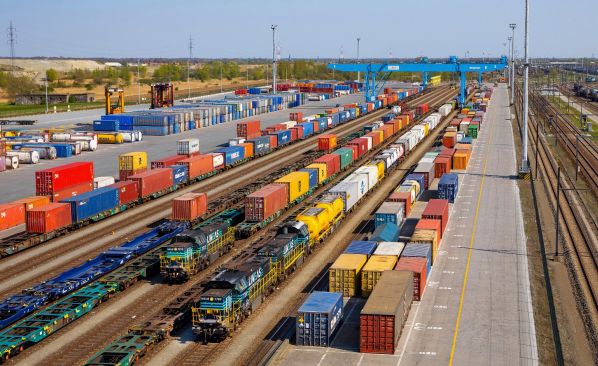“SIMPLY unrealistic” was the verdict of a European Court of Auditors (ECA) report published on March 27 on Europe’s targets for modal shift of freight to rail. Speaking during a press conference to announce the findings of a study on intermodal rail freight, Ms Annemie Turtelboom, the ECA member who led the audit, confirmed that Europe is not on course to achieve its targets for green freight transport.
“Trucks are still ruling the freight transport world and intermodal freight transport just cannot compete on equal grounds with road transport, which is often much cheaper, faster and more flexible,” Turtelboom said.
These targets are enshrined in the European Transport White Paper of 2011, the European Green Deal of 2019 and the Sustainable and Smart Mobility Strategy of 2020. This latter document set a broad target of increasing rail freight volumes by 50% by 2030 and 100% by 2050. Yet the ECA report says these ambitions are not based on a robust simulation of how much modal shift can realistically be achieved. With member states not required to comply and largely setting their own targets, the ECA says it is “impossible to assess whether combined national efforts are enough to meet the EU’s overall modal shift objectives.”
In 2022 rail’s share of freight transport in Europe stood stubbornly at 16.8% of all volumes. Rather than increase as hoped, volumes have fallen from 18.3% in 2011 and 17.7% in 2018. This is in spite of €1.1bn being allocated from various European Union (EU) programmes to support numerous rail freight improvement projects between 2014 and 2020, a level of financial support which prompted the ECA report.
The conditions that many believe are essential for rail freight to achieve these goals remain largely absent.
European rail freight is at a crossroads. Traditionally an underdog with slim margins, rail’s status as a comparatively efficient and green transport mode is placing the rail freight sector under intense pressure to improve performance and expand market share. Freight operators appear enthusiastic to deliver and grow their businesses. Political will is also seemingly there. Yet as the ECA report states, and as we find in this month’s issue of IRJ, the conditions that many believe are essential for rail freight to achieve these goals remain largely absent.
Insufficient network capacity and inadequate path allocation; infrastructure shortfalls; poor data on service availability; poor cross-border coordination; restrictive language requirements; and high access charges are all common complaints of rail freight operators and proponents, and all too familiar to long-time IRJ readers. Things clearly need to change.
Helpfully, the ECA report does offer some recommendations for how to overcome these shortcomings, as does a declaration signed by the CEOs of freight operators and several European bodies on March 29.
The ECA recommends setting targets for modal share on the TEN-T Core Network Corridors and to report on progress; preparation of regulatory changes to improve the competitiveness of intermodal transport; laying the groundwork for a coordinated assessment by member states of intermodal needs; and assessments of the modal shift potential in cost:benefit analyses of EU-funded projects.
Likewise, the declaration offers several suggestions for the European Commission (EC). Among them is a possible cap on the cost of electricity for freight operators; reductions in track access charges; equal treatment of rail alongside other modes in transport legislation; and targeted investment in infrastructure, rolling stock, digitalisation and technology which frees-up network capacity. The declaration’s signatories hope their proposals will influence the EC’s 2023 work programme and Green Transport Package, which will be presented later this year.
The ECA report addresses only intermodal traffic. However, there are other rail freight market segments where it is possible to grow volumes. As consultant Mr Jürgen Maier-Gyomlay points out, increasing single wagon load (SWL) traffic is one way to contribute substantially to increasing rail freight’s market share. SWL is much maligned and overlooked by policymakers, according to Maier-Gyomlay.
It is largely the preserve of state-owned operators and heavily subsidised, offering little incentive to innovate. Yet, as Maier-Gyomlay argues, a fundamental rethink and redesign of SWL, including by embracing “coopetition,” has the potential to transform the viability of not just SWL, but the entire rail freight sector.
“The goal must be a self-sustaining and market-based system that includes all freight operators without discrimination on the basis of intramodal competition and that is reliably available to all shippers,” Maier-Gyomlay writes.
Both the declaration and Maier-Gyomlay emphasise the importance of delivering the Digital Automatic Coupler (DAC) as a means of bringing rail freight into a new age, including facilitating digitalisation. Yet there is concern about who pays for this rollout. Smaller Eastern European freight operators led by the Federation of Independent Rail Operators (ZNPK) have estimated the cost of the DAC rollout at €15-20bn. This is well above the estimate of €10.6bn produced by the EC and Europe’s Rail, which have attempted to allay fears over progress with testing and deployment and the current lack of funding.
As the declaration signed by freight operators emphasises, the 30% target is only realistic if an ambitious approach is adopted by EU institutions. This should also extend to member states. Germany’s commitment to achieving a 25% market share is encouraging as are similar pledges by other member states. Yet, as the ECA states, and as Medway CEO, Mr Bruno Silva, argues these actions need to be coordinated.
Likewise, both member states and the EU should embrace relaunching SWL as a viable service and commit to funding DAC as a key enabler for future growth. The time for talk is now over. If rail is to carry a lot more of Europe’s freight by the middle of this century, helping to reduce transport emissions, we need action, and fast.

